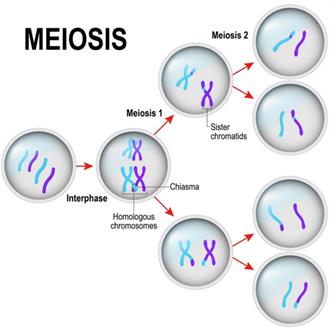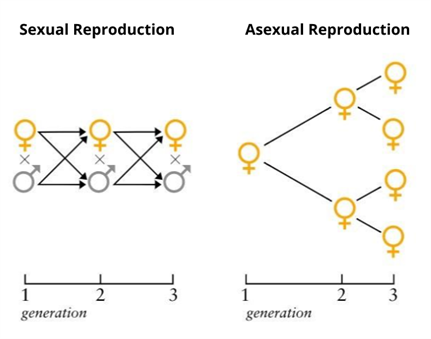PDF chapter test TRY NOW
As we know already that, before the cell starts to divide, the genetic material must also be made to ensure that each new daughter cell consists of DNA.
But here, the copies of DNA do not contain the same information inherited from the original DNA molecule during gamete formation through meiosis. So, in this case, each daughter cell would not have the same information duly inherited from the parental cell.
Eventually, it will lead to variation, and it is because of sexual reproduction.
The fusion of a haploid male and female gamete results in forming a diploid zygote called sexual reproduction or amphimixis.

Meiosis or reductional division
- It involves two parents, i.e., biparental.
- Gametes are haploids produced by meiosis.
- The process called fertilisation occurs in sexual reproduction, which leads to variations in the generations.
- Variations occur due to the combination or mixing of genes during crossing over.
- Daughter cells are genetically different from the parents.
Advantages of sexual reproduction over asexual reproduction:
Fusion of male and female gametes leads to variations and diverse characters in the offspring and the production of a new combination of genes that play a prominent role in the origin of new species, leading to the variation required for evolution.
Differences between sexual and asexual reproduction:

Sexual and asexual reproduction
| S.No | Sexual reproduction | Asexual reproduction |
| 1. | It occurs by the fusion of male and female gametes. | Fusion of male and female gametes is not seen here. |
| 2. | It involves two individuals. | It involves only one individual. |
| 3. | It involves germ cells of the body. | It involves somatic cells of the body. |
| 4. | Offsprings produced in sexual reproduction show variation. | Offsprings produced in asexual reproduction are exactly similar to their parent. Hence, called clones. |
| 5. | They are evolutionary advantageous. | They are not evolutionary advantageous. |
| 6. | Both meiotic and mitotic division take place. | Only mitotic divisions occur. |
| 7. | It is a slow process. | It is a fast process. |
| 8. | It is seen in higher plants and animals. | It is seen only in lower invertebrates and lower plants. |
Reference:
https://upload.wikimedia.org/wikipedia/commons/9/96/SexuellAsexuell.svg
